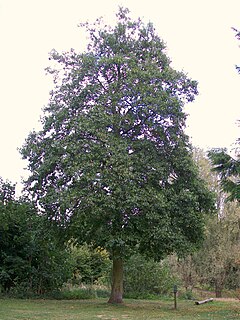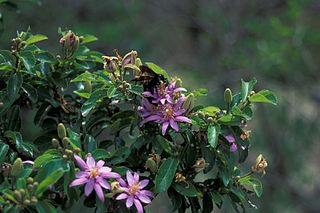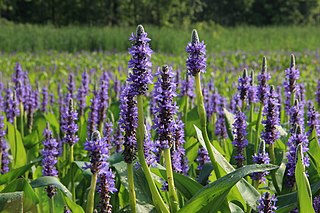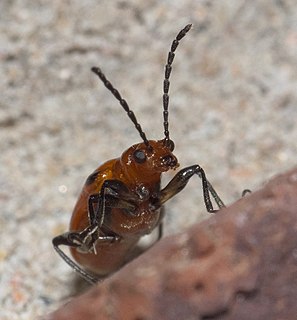
Ampelopsis, commonly known as peppervine or porcelainberry, is a genus of climbing shrubs, in the grape family Vitaceae. The name is derived from the Ancient Greek: ἅμπελος (ampelos), which means "vine". The genus was named in 1803. It is disjunctly distributed in eastern Asia and eastern North America extending to Mexico. Ampelopsis is primarily found in mountainous regions in temperate zones with some species in montane forests at mid-altitudes in subtropical to tropical regions. Ampelopsis glandulosa is a popular garden plant and an invasive weed.

Aleurites is a small genus of arborescent flowering plants in the Euphorbiaceae, first described as a genus in 1776. It is native to China, the Indian Subcontinent, Southeast Asia, Papuasia, and Queensland. It is also reportedly naturalized on various islands as well as scattered locations in Africa, South America, and Florida.

Alnus cordata, the Italian alder, is a tree or shrub species belonging to the family Betulaceae, and native to the southern Apennine Mountains and the north-eastern mountains of Corsica. It has been introduced in Sicily and Sardinia, and more recently in Central-North Italy, other European countries and extra-European countries, where it has become naturalised.

Thunbergia is a genus of flowering plants in the family Acanthaceae, native to tropical regions of Africa, Madagascar and southern Asia. Thunbergia species are vigorous annual or perennial vines and shrubs growing to 2–8 m tall. The generic name honours the Swedish naturalist Carl Peter Thunberg (1743-1828).

Houttuynia cordata, also known as fish mint, fish leaf, rainbow plant, chameleon plant, heart leaf, fish wort, Chinese lizard tail, or bishop's weed, is one of two species in the genus Houttuynia. It is a flowering plant native to Southeast Asia. It grows in moist, shady locations.

The large flowering plant genus Grewia is today placed by most authors in the mallow family Malvaceae, in the expanded sense as proposed by the Angiosperm Phylogeny Group. Formerly, Grewia was placed in either the family Tiliaceae or the Sparrmanniaceae. However, these were both not monophyletic with respect to other Malvales - as already indicated by the uncertainties surrounding placement of Grewia and similar genera - and have thus been merged into the Malvaceae. Together with the bulk of the former Sparrmanniaceae, Grewia is in the subfamily Grewioideae and therein the tribe Grewieae, of which it is the type genus.

Neottia cordata, lesser twayblade or heartleaf twayblade is an orchid of upland bogs and mires that rarely exceeds 15 cm in height. It was formerly placed in the genus Listera, but molecular phylogenetic studies have shown that Neottia nidus-avis, the Bird's-nest Orchid, evolved within the same group.

Pacaya–Samiria National Reserve, is a protected area located in the region of Loreto, Peru and spans an area of 20,800 km2 (8,000 sq mi). It protects an area of low hills and seasonally flooded forest in the Amazon rainforest.

Pontederia cordata, common name pickerelweed (USA) or pickerel weed (UK), is a monocotyledonous aquatic plant native to the American continent. It grows in a variety of wetlands, including pond and lake margins across an extremely large range from eastern Canada south to Argentina. A few examples include northern rivers, the Everglades and Louisiana.
Pyrus cordata, the Plymouth pear, is a rare wild species of pear belonging to the family Rosaceae. It gets its name from the city of Plymouth in Devon, where it was originally found in 1870 The Plymouth pear was one the British trees to be funded under English Natures Species Recovery Programme.
Cucurbita cordata is a species of flowering plant in the squash family. It is similar to Cucurbita californica, Cucurbita cylindrata, Cucurbita digitata, and Cucurbita palmata and all these species hybridize readily. These species form the only restricted xerophyte species group in the genus Cucurbita. Each member of this species group is native to the Southwestern United States and Northwestern Mexico where they are relatively uncommon. Each group member is found in hot, arid regions with low rainfall. They prefer soil that is loose, gravelly, and well-drained. C. cordata is found only in the vicinity of Bahía de los Ángeles, Baja California. Botanists Bemis and Whitaker suggest that C. cordata and C. cylindrata may be a case of sympatric speciation. The juvenile leaves of C. cylindrata, C. cordata, C. digitata, and C. palmata show a high degree of similarity, but their mature leaves are visibly different, as are their root structures. C. cordata fruits are gray green, striped, and round.
Cucurbita cylindrata is a species of flowering plant in the squash family. It is similar to Cucurbita californica, Cucurbita cordata, Cucurbita digitata, and Cucurbita palmata and all these species hybridize readily. These species form the only restricted xerophyte species group in the genus Cucurbita. Each member of this species group is native to the Southwestern United States and Northwestern Mexico where they are relatively uncommon. Each group member is found in hot, arid regions with low rainfall. They prefer soil that is loose, gravelly, and well-drained. C. cylindrata is found only in the middle portion of Baja California, mostly in Baja California Sur. Botanists Bemis and Whitaker suggest that C. cordata and C. cylindrata may be a case of sympatric speciation. The juvenile leaves of C. cylindrata, C. cordata, C. digitata, and C. palmata show a high degree of similarity, but their mature leaves are visibly different, as are their root structures. C. cylindrata fruits are dark green, striped, and round.

Neolema ovalis is a species of leaf beetle in the family Chrysomelidae. It is found in North America.

Neolema is a genus of leaf beetles in the family Chrysomelidae. There are about 8 described species in Neolema.
Neolema quadriguttata is a species of leaf beetle in the family Chrysomelidae. It is found in North America.

Neolema sexpunctata, the six-spotted neolema, is a species of leaf beetle in the family Chrysomelidae. It is found in North America.
Neolema dorsalis is a species of leaf beetle in the family Chrysomelidae. It is found in the Caribbean Sea, Central America, North America, and South America.
Neolema ephippium is a species of leaf beetle in the family Chrysomelidae. It is found in North America.

Callopistria cordata, the silver-spotted fern moth, is a species of owlet moth in the family Noctuidae. It is found in North America.

Mickelopteris is a genus of ferns in the subfamily Cheilanthoideae of the family Pteridaceae with a single species Mickelopteris cordata. Synonyms include Parahemionitis cordata and Hemionitis cordataRoxb. ex Hook. & Grev. The species is native to south-eastern Asia, from India to Taiwan and the Philippines.












